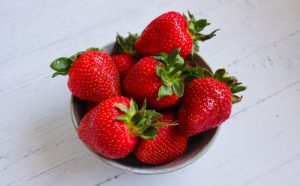The Norwegian growing season is fairly short – starting in late June Because of the short season only certain fruits thrive. Thanks to the cooler summer weather and long daylight hours some of the best suited fruits are berries. So it should come as no surprise that Norwegians are wild about foraging and picking berries. Berries that cannot be used immediately are frozen, or made into jam.
Are Norwegian strawberries the best? Apparently the are according to a survey done in a blind test between strawberries from Belgium, the Netherlands, Sweden and Norway done in Oslo by the newspaper Aftenposten. Result:
 9 of 13 testers preferred the Norwegian
9 of 13 testers preferred the Norwegian- 2 of 13 testers preferred the Swedish
- 1 of 13 preferred the Dutch
- 1 of 13 preferred the Belgian
Strawberries. Jordbær (strawberries) are the first to ripen, generally in late June, and are one of the high points of summer. Norwegians will buy up flats of local strawberries or go berry picking. So much so, that the locations of wild strawberry patches are well-guarded family secrets.

Norwegian strawberries are smaller than imported strawberries, a deeper red and more flavorful. Strawberries are usually enjoyed fresh with sugar and/or cream, or in the strawberry cake like the recipe here!
Cloudberries. Multer/Molter/Moltebær are often called the crown jewel of Norwegian fruit. They grow above the Arctic Circle in marshes and resemble large orange-pink raspberries. Multer only grow in the wild and cannot be farmed, so you either have to forage your own or pay as much as $20 per pound because they can be hard to come by. Known as viddas gull (highland gold), multer are delicate and juicy, and flavored like sweet-tart apples. They have to be hand-picked, and if you fill a bucket, the layer at the bottom will quickly become juice. There are sacred codes surrounding multer – you never pluck them before they are ripe (it’s actually illegal), and you are required to hike in and out. This way, no one person makes off with all of the harvest.
 Some other berries you will find include:
Some other berries you will find include:
Tyttebær (cowberries/lingonberries) which taste similar to cranberries
Krøkebær/krekling (crowberries) which look like blueberries but are black and mainly used in juice
Moreller (morello cherries)
Bjørnebær (blackberries) which people grow in their yards
Blåbær (bilberries) are also known as Swedish blueberries (Odon), or Arctic blueberries are used in juices, tea, desserts and syrup
Rips (red currants) and solbær (black currants) are harvested late into September and are used to make juice, wine, liqueur and jam
Elgbær (moose berries) grow close to the ground, and if you see some, you should be on the lookout for nearby moose
Bringebær (raspberries) (Hallon in Sweden) are used in sauces, cakes, and jams and grow in the wild, in gardens and on farms such as this:
If you are looking for a way to start your morning with a Scandinavian berry treat you can try blueberry porridge from the ScandiKitchen and found in ScandiKitchen Summer cookbook. The recipe is found here (courtesy of the ScandiKitchen website)